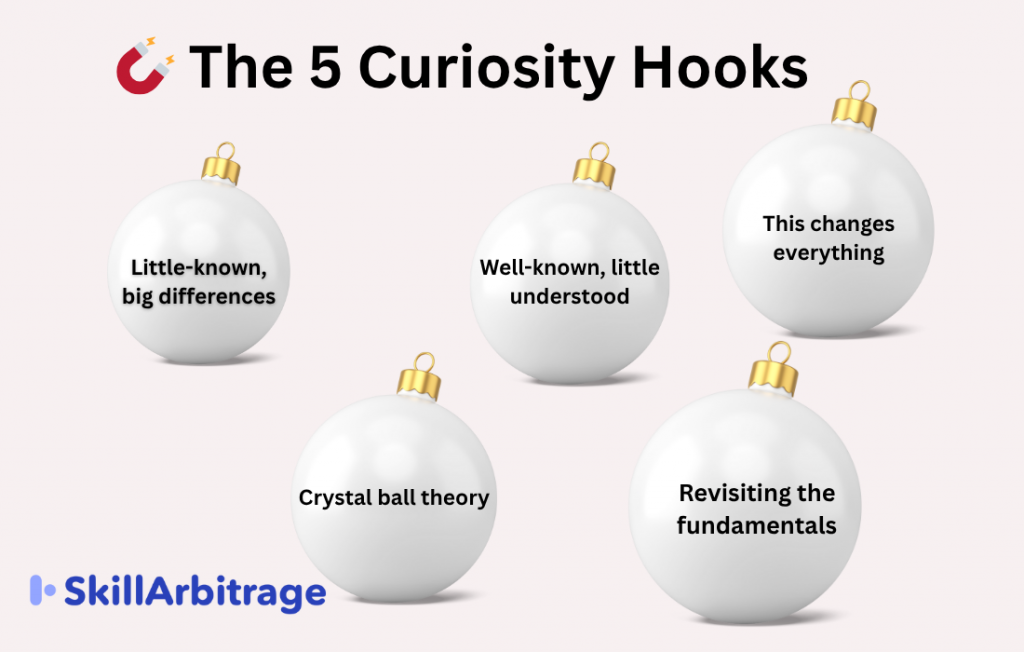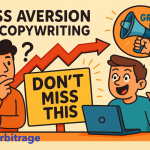This article shows coaches and the freelancers who write for them how to use five curiosity-driven hooks to frame a masterclass in a way that feels fresh, urgent, and impossible to ignore. You’ll walk away with a simple positioning tool that makes strangers sign up, lean in, and see you as the expert they have been looking for.
Previously in Manifesto…
Savitha helped Bhairavi turn her nerves into clarity by guiding her through a 5-part manifesto writing framework. The result? A bold, specific message Bhairavi could rally women around, online and on stage.
This time, Savitha is gearing up to launch a workshop for coaches and content creators. In a late-night brainstorm with Raja and Harsh, she breaks down five curiosity-driven hooks that turn forgettable masterclasses into can’t-miss events.
(Continued…)
Raja was pacing in shorts. Harsh was typing furiously on the dining table, muttering about sock metaphors.
They’d just gotten off a call with a US sports apparel brand. Big money. Big reach. Big ask: “We want you guys to fix our post-purchase email journey. Can we start Monday?”
Raja cracked his knuckles. “We say yes, right?”
Harsh nodded. “We loop in Savitha today. Get her to sanity-check the offer.”
But Savitha wasn’t listening.
She was on the couch, curled up with her Kindle, staring through the pages like they’d wronged her.
“Earth to marketing, Mataji,” said Raja. “What’s going on?”
Savitha blinked, looked up, and slowly closed the book.
“Did you know there are over 109,000 certified coaches worldwide?” she said.
Raja raised an eyebrow. “Wow. That’s a lot.”
“And the coaching industry in Asia has grown 86% in recent years. India’s catching up fast,” she said. “And that’s just the certified ones. You add all the uncertified coaches, course builders, indie creators, consultants… it’s massive. Quiet, but explosive.”
Harsh looked intrigued. “Where’s this going?”
“I want to be a Coach Coach,” Savitha said. “Help these small-but-serious creators build their brand and grow their revenue. Not just logos and websites. Positioning, messaging, and go-to-market strategy. The real stuff.”
Raja frowned. “Okay, but… they’re niche. Obscure. You said no to FabIndia last week. You’re saying yes to people whose mom doesn’t even understand what they do?”
“That’s exactly the point,” Savitha said. “No one’s cracked the cold traffic copy for these folks. You figure that out, you don’t just write copy. You define the category.”
Harsh leaned back. “So what’s your first move?”
Savitha smiled. “A workshop for coaches and consultants. Teaching them how to create curiosity for their first offer, usually a webinar or a challenge. I’ve been working on five specific hooks. Jason Fladlien calls them the Five Curiosity Hooks. I think they’re a game-changer.”
Raja reached for his notebook. “Alright. Let’s hear them.”
1. Why most masterclasses get ignored
Raja reached for his notebook. “Alright. Let’s hear them.”
Savitha shook her head. “Not yet. First, let’s talk about why most of these masterclasses get ignored in the first place.”
Harsh frowned. “You mean like ‘5 Steps to Grow Your Coaching Business’?”
“Exactly,” she said. “Or ‘How to Build Your Brand Online.’ Or ‘How to Monetize Your Passion.’”
She mimed falling asleep.
“They’re accurate,” Raja said. “Clear, even.”
“Clear is not the same as clickable,” Savitha said. “When you’re running ads to cold traffic, clarity isn’t what gets the click. Curiosity does.”
Harsh was already nodding. “It’s like email subject lines. If you say, ‘Here’s your discount coupon,’ cool. But if you say, ‘I wasn’t supposed to send this,’ you open it just to see what you weren’t supposed to get.”
“Exactly,” said Savitha. “These coaches are taught to be helpful, not to be interesting. So they write webinar titles like they’re labeling a YouTube playlist. Straight, boring, zero tension.”
Raja flipped his notebook shut. “So no ‘7 Steps,’ no ‘How To,’ no vague promises. Got it. But what do you write instead?”
Savitha smiled. “That’s what the hooks are for.”
Harsh leaned forward. “Let me guess, murder mystery, but make it coaching?”
“Close,” Savitha said. “You need a line that taps into the itch the audience didn’t know they had. That’s how you stop the scroll. Once they’re in, then you can be clear. But top-of-funnel? Curiosity is king.”
She paused. “Or queen, since I’m building this thing.”
Raja grinned. “Okay, Coach Coach. Hit us with the first one.”
2. 5 curiosity hooks that make people sign up instantly
Savitha took out her iPad and opened Notability. “There are five hook types I’m going to build this first masterclass around. I call them curiosity frames. Each one grabs attention differently, depending on what kind of coach you’re writing for.”
She drew a quick pentagon on the screen. “These are the five.”
Hook 1: Little-known, big differences
She circled the top corner.
“This one’s for when you want to say, ‘There’s something most people overlook, but once you spot it, you can’t unsee it.”
Raja raised an eyebrow. “Like what?”
“Like… ‘Most coaches obsess over pricing. But the top 1% all do this one thing before they ever mention a price.’”
Harsh tapped the table. “It plants a question. What’s the one thing? Why don’t I know it?”
“Exactly. It flips the power dynamic. Suddenly, you’re not just another coach. You’re the person who knows something others don’t. It works best when your client has strong opinions about something and you can gently explode them.”
Hook 2: Well-known, little understood
She moved to the next corner.
“This is for when the audience already knows the term but not what it really means. You turn a familiar word into a fresh rabbit hole.”
Harsh nodded. “Like… ‘funnel’?”
Savitha laughed. “Yup. Imagine, ‘You’ve heard of personal branding. But have you ever seen how it actually works in the wild?’ You’re saying, ‘This thing you thought was simple? You’ve only scratched the surface.’”
Raja scribbled that down. “So this one’s about re-seeing the obvious.”
“Exactly. It’s great for leads who think they’ve already tried everything.”
Hook 3: This changes everything
She drew a lightning bolt in the third corner.
“This is your classic disruptive hook. Use it when you’re introducing something genuinely new or framing something old in a completely unexpected way.”
Harsh leaned in. “Give us one.”
Savitha didn’t skip a beat. “‘Why the smartest coaches are quitting Instagram and where they’re going instead.’”
Raja raised both eyebrows. “That would stop me.”
Hook 4: Crystal ball theory
She tapped the fourth point.
“This is the prediction angle. You’re telling the audience, something big is coming, and here’s how to prepare.”
“Like a market trend?” Raja asked.
“Exactly. For example: ‘The creator gold rush is ending. Here’s what comes next and who wins.’”
Harsh smirked. “And if I don’t click, I’m going to miss the train.”
“It hits on FOMO, but in a thoughtful way,” Savitha said. “You’re not screaming urgency. You’re just showing them the future and inviting them to step into it early.”
Hook 5: Revisiting the fundamentals
She finished the pentagon with a firm stroke.
“This is the anti-hype hook. The one that says: screw trends, let’s go back to what works.”
Raja looked intrigued. “Isn’t that risky? Isn’t everyone chasing novelty?”
“Not always,” Savitha said. “Some people are burned out from hacks and quick wins. For them, a hook like ‘The one habit every successful coach builds before their first client’ feels like relief.”
Harsh tilted his head. “It reframes basics as secrets.”
“Exactly. When done right, it doesn’t feel basic. It feels foundational. Like you’ve been skipping a step that actually matters.”
She looked up. “So those are the five. Each one builds curiosity in a different way. But the goal’s always the same. Stop the scroll, earn the click, win the signup.”
Raja leaned back. “Okay, Coach Coach. You’ve got your curriculum. When’s the first class?”
Savitha grinned. “Soon. But first… I need to test them in the wild.”
3. How to choose the right hook for your offer
Raja leaned back, arms crossed. “Okay. Say I’m a breathwork coach. I help people manage anxiety through breathing. Which hook should I pick?”
Savitha didn’t flinch. “First, who’s the cold audience?”
“Hmm. Professionals in their thirties. Burned out. Scrolling Instagram between Zoom calls.”
“Good. What do they believe right now?”
“That anxiety is just part of life. Maybe they think they need therapy, or meds. Breathwork sounds… soft.”
Savitha nodded. “So they’ve heard of it. But don’t respect it.”
She drew two boxes on the whiteboard.
What they believe:
Breathwork is spiritual fluff. Not serious.
What we know:
Breathwork can physiologically reset your nervous system faster than most coping mechanisms.
Harsh leaned in. “So the tension is: what sounds woo can actually outperform the mainstream options.”
Savitha circled it. “That’s your opening. So now we test hooks that frame that tension.”
Option 1: Little-Known, Big Differences
“The simple 4-minute technique that outperforms journaling, therapy, and sleep.”
“This hits the performance angle,” Savitha said. “It implies there’s a better path, just hidden.”
Option 2: Well Known, Little Understood
“You’ve heard of breathwork. But you probably don’t know what it really does to your body.”
“Here, we’re not challenging their exposure,” she said. “We’re challenging their understanding.”
Option 3: This Changes Everything
“What if I told you anxiety isn’t a mental problem and your breath is the proof?”
“That reframes the problem itself,” Raja said. “Makes breathwork feel like a breakthrough, not a supplement.”
Option 4: Crystal Ball Theory
“Why the next wave of stress therapy isn’t talk-based. It’s breath-based.”
“This works if the audience is trend-sensitive,” Harsh said. “It puts them ahead of the curve.”
Option 5: Revisiting the Fundamentals
“Before your next therapy session, try this.”
“Subtle. For skeptics,” Savitha nodded. “It doesn’t argue. It invites.”
She stepped back. “Now, which one do we pick?”
Raja thought for a second. “I’d go with Option 3. ‘This Changes Everything.’ The anxiety reframing is provocative, but not clickbait. It matches the shift we’re actually promising.”
Savitha smiled. “Exactly. That’s the process. Start with the audience’s current belief. Isolate the tension. Then run each hook format through that lens and pick the one that frames the shift most powerfully.”
Harsh was already scribbling. “We need a worksheet for this.”
Savitha grinned. “You just volunteered to make it.”
4. For coaches and freelancers who write for them
Harsh was typing furiously, building a Notion doc with all five hooks laid out.
Raja glanced over. “You realise this is not just useful for coaches, right?”
Savitha raised an eyebrow. “What do you mean?”
“I mean us. Freelancers. If I pitch a hook like that to a coach for their next launch, I look like a strategist. Not just a copywriter.”
Savitha nodded. “Exactly. That’s why I’m teaching this. Coaches need better cold traffic hooks. And freelancers need better warm intros.”
Harsh turned his screen around. “Here. Tell me this isn’t a great pitch email.”
Subject line:
This hook helped a gut-health coach 3x her webinar signups in 7 days.
Body:
Hey [Name],
Saw you’re prepping for a launch. Wanted to float a copy angle that’s been converting cold audiences like crazy.
It’s called the “Well-Known, Little Understood” hook.
You’ve probably heard of it. But you may not know how to use it in a webinar funnel. I’ve been testing 5 such frameworks that reframe the same offer in radically different ways depending on audience awareness.
If you’re open to a 10-minute jam, I can show you what it could look like for your offer.
Cheers,
Harsh
Raja read it twice. “It’s not even a pitch. It’s a preview. You’re showing them what it’s like to work with you without asking for anything.”
Savitha grinned. “That’s how you sell to coaches. Don’t flatter them. Don’t pitch services. Just make them feel like they’re in the presence of someone who gets how attention works.”
Harsh was on a roll now. “You could even open a call with: ‘Which of these five tensions best describes your audience’s mindset right now?’ And build the hook live.”
Raja pointed at him. “That’s the pitch.”
Savitha leaned back, arms behind her head. “You’re not just copywriters anymore. You’re hook advisors.”
Harsh smirked. “Coach coaches?”
Savitha shook her head. “Don’t push it.”
They all laughed.
But the mood had changed. Something had clicked.
This wasn’t just a framework for writing better webinar titles.
It was a framework for becoming more valuable.
To clients. To audiences. To themselves.
(To be continued…)







 Allow notifications
Allow notifications
